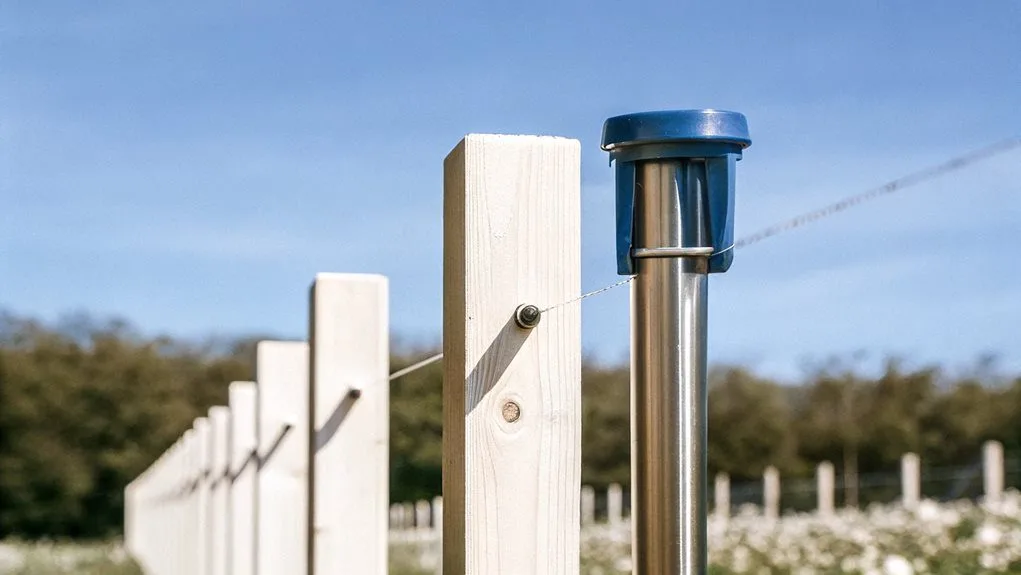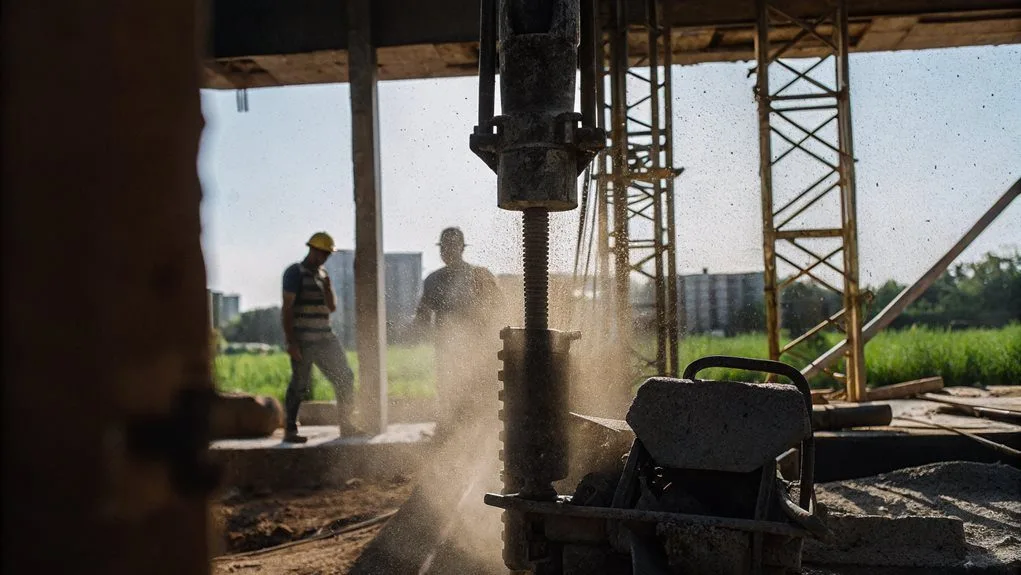So, you think a compactor plate is just a noisy hunk of metal? Think again! It tackles everything from solid foundations to those pesky garden pathways you keep ignoring. Need a level surface for your patio? Check. Want to prevent erosion in your flower beds? Got it. And if you’ve ever dealt with muddy gravel, well, you’re in luck!
A little dirt magic goes a long way with these versatile machines. Stick around, and you might uncover even more surprising uses for your compactor plate across various surfaces and landscaping projects.
Key Takeaways
- Plate compactors are ideal for compacting granular materials, stabilizing soil for structures, and preventing air pockets in various surfaces.
- They effectively prepare surfaces for interlocking pavers, driveways, and patios, ensuring stability and preventing settling.
- Use compactors on gravel pathways, applying layers and compacting to improve density and prevent erosion.
- Suitable for landscaping projects, compactors can help create sturdy foundations for walkways and outdoor features.
- Compactors can assist in environmental projects, reinforcing soil and preventing erosion on slopes with materials like geotextiles and riprap.
Building Foundations
When it comes to building foundations, you’ve got to get it right. If you don’t, well, good luck with your leaning tower of… something.
Compactors are your best mates here. They squash soil into submission, keeping air pockets at bay. Heavy steel plates generate downward force that exerts powerful compaction through vibration. This process is essential for ensuring a stable base as plate compactors compact granular materials effectively, providing the necessary support for the weight of the structure.
Imagine your foundation settling like a bad joke—no thanks!
A foundation that settles like a punchline? No thanks—let’s keep the humor out of construction!
You need the right compacting force for that heavy load your future castle might carry.
Don’t think all soil’s created equal, either; compacting clay is quite the diva compared to gravel.
And, of course, you’ll have to look at your project’s size, because a massive compactor on a small project? That’s just embarrassing.
Landscaping and Planning
So, you’ve got your solid foundation set and now you’re ready to design like a pro.
But wait, you thought you could skip compacting? Good luck with that!
For a patio or walkway, not compacting the base is like making a cake without flour—it’s all going to crumble! You’re gonna want that sturdy, level surface, right? Compaction prevents settling and maintains the integrity of your outdoor features, providing a reliable base for years to come. It also ensures that your foundational layers are compact and stable for walkways and patios.
Think of garden beds too. A little compaction goes a long way in keeping soil from washing away.
And driveways? They aren’t just made for parking; they’re a statement! You want interlocking pavers to stay put, not wiggle like they’re in a dance-off!
Material Compaction
You think you can just toss down some gravel and call it a pathway? Not quite! If you want your gravel to stick around and not turn into a muddy mess after the next rain, you’re gonna need to compact that soil first—trust me, future you’ll be grateful. Compaction requirements for projects ensure that the surface remains stable and durable for years to come. Using a plate compactor is essential for achieving optimal density and stability in your gravel pathway.
Soil Density Improvement
Soil density improvement might sound like something only construction enthusiasts care about, but trust me, it’s essential. You don’t want your future patio sinking, do you? By compacting the soil, you’re basically squeezing out the air and making it stronger. This means no more settling or unexpected boggy spots in your garden. Clay soils? They need a bit of TLC. Sandy soils thrive on vibratory compaction. You might think, “Why do I need to bother?” But think of it this way: solid ground equals a sturdy foundation for whatever dreams you’re building. Plus, it minimizes water issues and troublesome soil shifts. Additionally, maximized density can be achieved when soil is compacted at its optimum moisture content, further enhancing stability. The process of compaction creates a homogeneous soil mass, which provides better support for pavements and structures placed on top.
Gravel Pathway Preparation
Creating a gravel pathway isn’t just about tossing some rocks on the ground and calling it a day.
If you want to build something that’ll last, you need processed gravel, not those cute pebbles you saw at the garden centre. Trust us, they don’t compact well.
Get a 35-centimetre plate compactor—you’ll thank yourself later.
Start with about 8 centimetres of gravel, compact each layer, and don’t skip the wetting part; it’s like giving your gravel a spa day.
Oh, and if you think one layer’s enough, well, good luck with that! Aim for 8 to 15 centimetres total.
Pour that gravel, compact it, then walk like you own the place.
Next up? You’ll be the gravel path guru everyone wants to befriend!
Environmental Uses
So, you think that compacting soil is just about making it look nice? Think again!
With slope stabilization techniques and erosion control strategies, your trusty plate compactor works overtime to protect habitats, proving it’s more than just a pretty face in landscaping.
Slope Stabilization Techniques
When you think about slope stabilisation techniques, you might imagine engineers battling nature with concrete and steel. But hold on! Many of you can join this cause.
Ever tried planting vegetation? That’s right—a plant’s roots do wonders for soil, keeping it all together.
Geotextiles? They’re like superhero capes for soil, filtering whilst letting water through.
And let’s not forget riprap; think of big rocks strategically placed, just chilling whilst protecting your slopes from erosion.
If it gusts too hard, soil reinforcement mats add that extra love.
Finally, hydroseeding‘s the quick fix for covering slopes.
Who knew stabilisation could be so friendly? So, gear up and show those slopes some love—you’ve got this!
Erosion Control Strategies
Forget what you’ve heard; erosion control isn’t just for the pros with hard hats and fancy tools. You can tackle it, too!
Sure, you mightn’t have soil nailing techniques up your sleeve, but plate compactors can help you stabilise those pesky slopes.
Compacting the soil increases resistance against water flow, so less sediment washes away into nearby water bodies.
It’s like giving your terrain a strong umbrella!
And don’t forget, with solid compaction, you reduce tripping hazards—nobody wants to topple over because of a muddy mess.
Habitat Protection Methods
Ah, the irony of using heavy machinery to protect delicate habitats! You might think that compaction is the antithesis of conservation. But it’s actually quite the opposite!
By stabilising soil during construction, you can avoid messing up the homes of our furry and feathered friends.
You’ll create compact pathways that don’t stomp all over plant life, giving indigenous species a chance to thrive.
Plus, who knew compactors could aid in wetland preservation? They can stabilise soil without wreaking havoc.
And let’s face it—who doesn’t love a good wildlife trail?
Maintenance and Repair
You’d think maintaining a plate compactor would be as easy as pouring a cup of coffee. But it’s more like brewing a complex espresso! Let’s start with cleaning; debris can cling on like an unwelcome houseguest.
Daily checks? Yes, you need to verify that everything’s working. Just remember to lubricate those moving parts—friction’s not your friend here.
Daily checks are crucial! Keep those moving parts lubricated—remember, friction is the enemy of smooth operation.
And please—change those filters! Ignoring oil checks is like leaving your engine on mute.
Now, let’s talk repairs. Tightening loose components isn’t glamorous, but it beats a meltdown during work. Forgetting to replace the timing belt? Well, that’s a one-way ticket to costly engine drama! Staying on top of maintenance keeps your compactor happy, healthy, and, hopefully, drama-free.
Specialized Applications
After making sure your plate compactor is purring like a satisfied cat, it’s time to put it to work beyond the basics.
You think compacting dirt is just for driveways? Think again!
Use your compactor to prep foundations and footings—because who wants a wobbly house?
It tackles asphalt and concrete paving like a pro, ensuring your surfaces are smooth and ready for action.
Trench work? You’ll love how it fits into those tight spots.
Need a solid lawn or garden bed? Yup, it helps with that too.
And hey, ever tried backfilling? Your plate compactor’s got your back there.
Conclusion
So, there you have it! From building foundations to battling nature in landscaping, compactor plates can be your heavy-duty sidekicks. Think your backyard’s only good for growing weeds? Think again! You can flatten that messy soil like you’re prepping for a barbecue. Just remember, this isn’t a magic wand—it won’t fix your neighbor’s fence or guarantee a perfect lawn. But hey, if you’re excited to tackle those surfaces, grab that compactor and let’s get to work!






